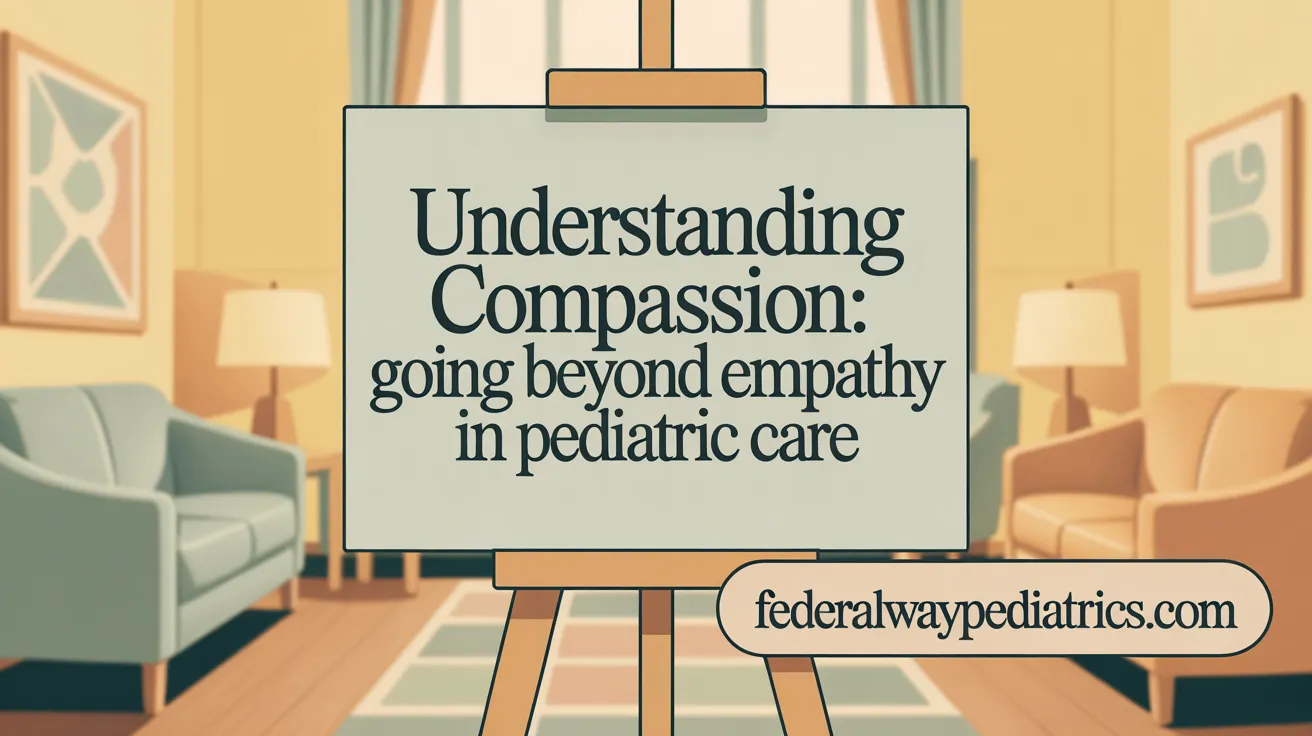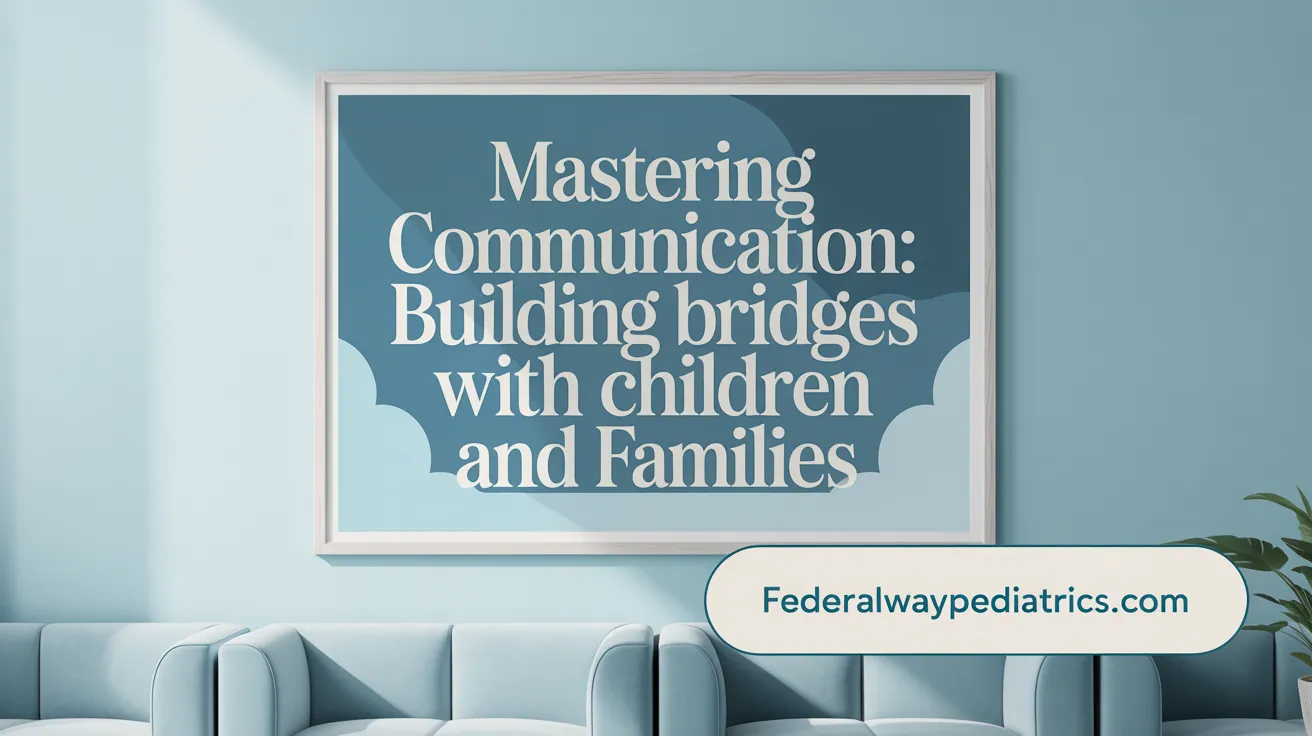The Heart of Pediatric Care: Compassion and Connection
Pediatric healthcare demands more than medical expertise; it requires a deep commitment to building compassionate relationships that address both the physical and emotional needs of children and their families. Compassion, empathy, and trust form the bedrock of effective care, ensuring young patients feel secure and valued while fostering positive health outcomes. This article explores the essential components of compassionate pediatric care and offers insights into nurturing these vital connections across healthcare settings.
Defining Compassion in Pediatric Healthcare

What constitutes compassionate care in pediatric healthcare?
Compassion in pediatric healthcare goes beyond simply feeling empathy; it is a benevolent and active response aimed at addressing the suffering and needs of both the child and their family. It involves a deep relational understanding and recognition of shared humanity, combined with meaningful actions to alleviate distress and promote well-being (Compassion in Pediatric Healthcare, Compassion in pediatric oncology).
What are the key domains of compassion based on empirical models?
The Pediatric Compassion Model, created from empirical studies involving patients, parents, and healthcare providers, outlines four fundamental domains:
- Beneficence: This involves healthcare virtues, awareness of suffering, and an active commitment to respond effectively (Four key domains of pediatric compassion.
- Human Relating: Genuine engagement with patients and families, acknowledging their humanity and building emotional connections (Human relating in pediatric compassion.
- Seeking to Understand: A proactive effort to comprehend the unique experiences and emotions of the child and family, allowing for personalized and sensitive care (Seeking to understand patient experience.
- Attending to Needs: Timely, attentive, and compassionate acts—ranging from small kindnesses to extraordinary efforts—that address suffering and support recovery (Attending to patient needs.
How do perceptions of compassion differ among patients, families, and healthcare providers?
Patients and families often emphasize the foundational role of beneficence and the personal virtues that motivate compassionate care. In contrast, healthcare providers tend to focus more on the tangible actions and communication strategies employed during care delivery. This difference highlights the complexity of compassion as both an emotional and practical construct (Healthcare providers’ views on compassion, Patients’ and parents’ perspectives on compassion.
How is compassion multidimensional beyond empathy and sympathy?
Compassion in pediatric care is not limited to feelings like empathy or sympathy. It is a multidimensional construct that encapsulates emotional understanding, ethical motivation, meaningful engagement, and concrete actions. This comprehensive approach ensures that compassionate care results in both emotional support and improved clinical outcomes for children and their families (Multi-dimensional compassion construct, Benefits of compassion in pediatric care).
Building Trust: The Cornerstone of Pediatric Relationships

Why is trust essential in pediatric healthcare?
Trust serves as the foundation of the therapeutic relationship between healthcare providers, children, and their families. It enhances communication quality and cooperation, enabling shared decision-making that is crucial for personalized care. When trust is present, children experience emotional comfort that alleviates fear and anxiety during consultations and procedures, making examinations smoother and less traumatic (Trust in pediatric healthcare, Building trust with pediatric patients).
What are the key attributes and antecedents of trustful relationships?
Trustful pediatric relationships are dynamic and reciprocal, defined by mutual curiosity, respect, and confidence. Key attributes include the healthcare professional’s genuineness, sympathy, friendliness, respectfulness, and professionalism. Communication strategies tailored to the child's developmental stage, such as age-appropriate language and positive verbal and non-verbal cues, are vital (Effective communication in pediatrics, Guide to communicating with children and young people). Environmental factors such as child-friendly spaces and continuity of care by a consistent caregiver team also support trust (Trust in pediatric healthcare). Antecedents influencing trust include a child’s developmental age, prior healthcare experiences, parental presence and concerns, and the broader cultural and organizational context (Establishing trusting relationships with families).
What strategies help establish and maintain trust with children and families?
Building trust involves genuine engagement with the child and family, active listening, and respecting the child’s personality and preferences (Effective Communication Strategies for Pediatric Healthcare, Tips for communicating with pediatric patients). Healthcare providers should use language suited to the child’s understanding and involve them in conversations and decision-making, fostering a sense of control and empowerment (Child-centred care principles, Building trusting relationships with children). Creating a welcoming, comfortable, and child-friendly environment reduces anxiety (Compassionate care in pediatrics. Preparing families through clear explanations and showing empathy toward their concerns strengthens relational bonds (Empathy in pediatric healthcare, Building trust and respect). Consistency and reliability, such as keeping promises and scheduling follow-ups, solidify trust over time (Establishing trusting relationships with families.
How does trust improve cooperation, satisfaction, and clinical outcomes?
Trust leads to greater child cooperation during medical exams and treatments, easing clinical procedures (Empathy in pediatric healthcare). Parents report higher satisfaction levels when they feel their family’s needs are respected and understood (Effective communication in pediatrics). Clinically, trust facilitates better health outcomes by encouraging adherence to treatment plans and reducing hospital stays (Trust in pediatric healthcare, Compassionate care in pediatric healthcare). Organizationally, it lowers the risk of errors and supports efficient care delivery. Overall, trust nurtures a positive, collaborative healthcare experience that benefits patients, families, and providers alike (Building trust in pediatric nursing, Impact of compassionate pediatric nursing).
Empathy: The Bridge to Understanding and Support
How does empathy influence relationships in pediatric healthcare?
Empathy plays a crucial role in pediatric care by fostering a safe and understanding environment where children feel acknowledged and genuinely cared for. This emotional connection enhances trust between the child, their family, and healthcare providers, which is essential for effective communication (Empathy in pediatric healthcare, Building trust in pediatric care.
Empathetic pediatricians and nurses can better read non-verbal cues such as facial expressions and body language, allowing them to tailor care to each child’s unique needs (effective communication with young children). This sensitive approach encourages cooperation during examinations and procedures, thereby reducing anxiety and fear commonly experienced by young patients (Approaching Pediatric Patients, Empathy in pediatric healthcare.
What are the benefits of empathy for patients and clinicians?
For patients, empathy eases distress by validating their feelings and fears, which improves adherence to treatment and clinical outcomes (Empathy in pediatric care, Impact of compassionate pediatric nursing. Families feel more supported, which fosters open dialogue and active participation in care decisions (Supporting caregivers in pediatric treatment.
Clinicians benefit from practicing empathy as well; it enhances their job satisfaction and reduces burnout by providing emotional fulfillment (Balancing empathy and professionalism in pediatric nursing). This resilience helps healthcare providers manage the stresses inherent in pediatric medicine.
How can pediatric healthcare providers develop and strengthen empathy?
Empathy is a skill that can be cultivated through targeted training programs, reflective practices, and mindfulness exercises (empathy clinical education, Empathy in pediatric nursing). Educational modules often include role-playing, simulations, and feedback sessions to improve clinicians' empathic abilities (Developing compassionate care strategies).
Continued development of empathy through these strategies supports compassionate care, helping providers build stronger, trustful relationships with children and their families (Building trust with pediatric patients, Building trusting relationships with families. This in turn promotes collaboration, better health outcomes, and a supportive healthcare environment (Effective communication in pediatrics.
Effective Communication: The Foundation of Compassionate Care

Communication techniques tailored to children's developmental stages
Communication in pediatric healthcare must be adapted to children's unique developmental levels. For infants and toddlers, gentle, calm interactions with clear, concrete explanations and choices help reduce stranger anxiety and build comfort. Preschoolers benefit from honest, tactile engagement, while school-age children appreciate privacy and involvement in care decisions explained at their level. Adolescents require respect for their autonomy, confidentiality, and mature explanations. Getting on the child's physical level, such as kneeling, fosters connection and reduces intimidation (Approaching Pediatric Patients).
Importance of verbal and non-verbal communication
Compassionate care relies heavily on both verbal and non-verbal communication strategies. Eye contact, positive facial expressions like smiling, good posture, and warm tone of voice signal empathy and openness. Clear, concise verbal explanations using age-appropriate language ensure understanding, while avoiding medical jargon or distressing terms fosters comfort. Non-verbal cues like nodding, gentle touch, and open body posture enhance trust and emotional safety (Effective communication in pediatric outpatient care, 9 Tips for Better Communication, Building trust with young patients.
Involving children and families in conversations and decision-making
Effective pediatric communication engages not only the child but also their family. Greeting the child first builds rapport, while including parents in discussions respects their role and concerns. Shared decision-making is promoted by involving children appropriately according to their age and maturity, which empowers them and respects their autonomy. Transparent, honest explanations and opportunities to ask questions support collaboration and strengthen trust (Guide to communicating with children and young people, Building trusting relationships with children, The Importance of Building Trust Between Parents and Pediatric Providers).
Strategies to reduce anxiety and empower pediatric patients
Reducing distress in pediatric patients is central to compassionate communication. Creating a child-friendly environment with colorful decorations, toys, and comforting items helps ease fear. Preparing children with honest, simple descriptions of procedures demystify unfamiliar experiences. Techniques such as distraction, therapeutic play, and involving children in tasks during procedures foster cooperation and resilience. Keeping children physically close to caregivers and validating their feelings reinforce emotional security and empowerment (Communicating procedures to children, Tips for communicating with pediatric patients, Creating child-friendly healthcare environments.
| Aspect | Description | Practical Tips |
|---|---|---|
| Developmental Tailoring | Adjust communication to child's age and cognitive level | Use concrete explanations; respect adolescent privacy |
| Verbal & Non-Verbal | Convey empathy through words and body language | Maintain eye contact; speak clearly; smile |
| Family Involvement | Include parents in dialogue and decisions | Engage parents; explain procedures; listen actively |
| Anxiety Reduction | Create supportive, calming environment | Use toys; explain procedures honestly; offer choices |
These combined strategies support compassionate pediatric care by fostering trust, minimizing fear, and empowering children and their families in healthcare settings (The Power of Compassionate Care in Pediatric Medicine, Compassion in Pediatric Healthcare).
The Role of Pediatric Nurses: Balancing Empathy and Professionalism
How do pediatric nurses balance empathy with professionalism in care?
Pediatric nurses skillfully balance empathy and professionalism by showing genuine understanding and emotional support to children and their families, while also maintaining objectivity and adhering to medical protocols. Emotional intelligence plays a vital role, enabling nurses to recognize and regulate their own feelings to respond effectively and maintain a composed environment. For more on balancing empathy and professionalism, see Balancing empathy and professionalism in pediatric nursing.
Building trustful, therapeutic relationships with pediatric patients and their families is fundamental. Through active listening, nonverbal cues like gentle touch and soothing tone, and consistent support, nurses foster a sense of safety and cooperation that enhances care quality. Learn more about building trust in pediatric nursing at Trust in pediatric nurse-patient relationships.
To sustain compassionate care, nurses manage stress by setting professional boundaries, practicing self-care, and seeking support when needed to prevent burnout and ensure ongoing resilience. For additional insights, see Impact of compassionate pediatric nursing.
Ongoing education is crucial; targeted empathy training and reflective practices help pediatric nurses refine their communication and relational skills. Such development leads to better patient cooperation, reduced anxiety, and improved clinical outcomes, underscoring the importance of continuous learning in cultivating compassionate professionalism in pediatric nursing. Explore more about empathy training for nursing students at role of empathy in nursing.
Creating Child-Friendly Environments to Foster Compassion

How does the healthcare environment affect compassionate pediatric care?
The physical setting of pediatric healthcare plays a crucial role in providing compassionate care. A welcoming, child-friendly environment can dramatically reduce anxiety and fear that children commonly experience in medical settings. Hospitals and clinics that incorporate colorful decor, toys, books, and comforting items create spaces where children feel more secure and valued.
Impact of physical environment on pediatric patient anxiety
An environment designed with the child's needs in mind helps diminish the stress associated with healthcare encounters. Familiar, playful elements distract from pain or discomfort and reduce feelings of vulnerability, supporting creating child-friendly healthcare environments.
Use of age-appropriate toys, colorful decor, and comforting items
Age-appropriate toys and visual stimuli engage children at their developmental level, helping them feel involved rather than passive in their care. Items like teddy bears, blankets, and books offer comfort and familiarity, providing emotional support, as highlighted in tips for communicating with pediatric patients.
Benefits of child-friendly spaces for engagement and cooperation
These supportive surroundings foster cooperation during examinations and procedures. Children who are comfortable and engaged tend to be less resistant and more compliant, which in turn facilitates smoother medical interventions and better outcomes, reflecting evidence from empathy and communication in pediatric care.
Inclusion of caregivers and the support they provide during care
Allowing caregivers to accompany children in these environments offers essential emotional reassurance. Parents and family members provide practical help and strengthen the child's sense of safety, contributing to a trusting relationship with healthcare providers, as emphasized in building trust in pediatric care.
Providing such thoughtfully arranged environments is an integral part of compassionate pediatric care. It promotes healing and well-being by addressing both emotional and physical needs through trusted, supportive settings. For further insights, see the power of compassionate care in pediatric medicine.
Engaging Children and Families: Empowerment Through Inclusion
How does involving children and families support compassionate care?
Involving children and their families actively in healthcare discussions empowers them and reduces feelings of helplessness. When children receive age-appropriate explanations and honest communication about their care, it demystifies medical procedures and eases their anxiety. This inclusion fosters greater cooperation during assessments and treatments, improving outcomes. For more on Effective Communication in Pediatric Medicine.
Techniques to prepare children for medical procedures
Preparing children for medical procedures is key to reducing distress. Techniques like distraction and therapeutic play help divert attention and make the experience less intimidating. Explaining procedures using child-friendly language and involving children in simple tasks—such as holding equipment or participating in assessments—enhances their engagement and sense of control. Comforting strategies include positioning the child comfortably near caregivers and using familiar toys or items to calm fears. See also Communicating Procedures to Children.
Addressing the emotional needs of children and families
Recognizing and validating the emotional responses of children and their families is crucial. Providing opportunities to express feelings and responding with empathy helps reduce anxiety and builds resilience. A supportive environment that respects the family’s concerns and experiences strengthens trust and promotes emotional well-being. For guidance on Building Trust in Pediatric Healthcare and the Power of Compassionate Care in Pediatric Medicine.
Collaborative decision-making and respect for autonomy
Respecting children's growing autonomy involves including them in decision-making processes appropriate to their developmental level. Shared decision-making incorporates family values and preferences, ensuring care plans align with their expectations. This collaborative approach fosters satisfaction, adherence to treatment, and nurturing, trusting relationships between healthcare providers, children, and families. For more on Advocacy for Pediatric Patients and Compassionate Care.
Embedding Compassion into Healthcare Systems and Education

How can healthcare systems embed and sustain compassionate pediatric care?
Embedding compassion in pediatric healthcare is a multi-layered effort requiring robust organizational support. Healthcare systems must cultivate a culture and leadership that prioritize compassion, providing resources and frameworks to support compassionate practices among providers (Embedding Compassion Across Healthcare Systems. Training programs play a vital role—approaches like the Facilitating Attuned Interactions (FAN) focus on enhancing empathy and reflective practice, which has shown to boost provider compassion and improve patient-family satisfaction (American Academy of Pediatrics and Erikson partnership).
Furthermore, integrating compassion and empathy training into educational curricula ensures that future pediatric providers develop essential skills early in their careers. This includes modules on relationship-building, communication tailored to children’s developmental needs, and managing emotional responses (Compassionate Care in Pediatric Medicine; Knowledge Simulation and Sharing module; Approaching Pediatric Patients.
Institutionalizing compassion as a performance indicator reinforces its importance in delivering quality care. Policies should emphasize that compassionate care is a shared responsibility throughout the healthcare system, promoting teamwork and continuity (Embedding Compassion Across Healthcare Systems; Compassion in Pediatric Healthcare.
Sustainability is supported through ongoing mentorship, regular assessment of compassionate care practices, and knowledge sharing to continually refine and uphold standards (Building trusting relationships with children; Compassionate care in pediatric nursing). These efforts collectively enhance clinical outcomes and enrich the experiences of children and their families in pediatric care (Impact of compassionate pediatric nursing; The Power of Compassionate Care in Pediatric Medicine.
Towards a Compassionate Future in Pediatric Healthcare
Compassion, empathy, and trust form the foundation of effective pediatric healthcare, shaping positive experiences and outcomes for children and their families. By understanding and implementing multidimensional compassionate care through skilled communication, emotional intelligence, and child-centred environments, healthcare providers can nurture healing relationships that extend beyond clinical interventions. Embedding these values within healthcare systems and education ensures sustainable, high-quality pediatric care. As the field continues to evolve, ongoing commitment to building compassionate relationships will remain essential to supporting young patients’ health, resilience, and well-being.
